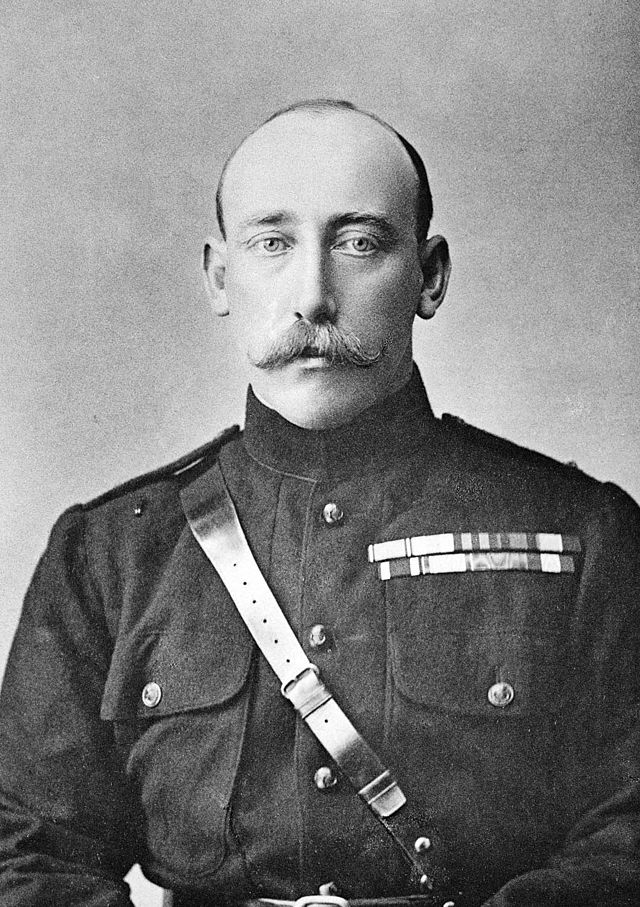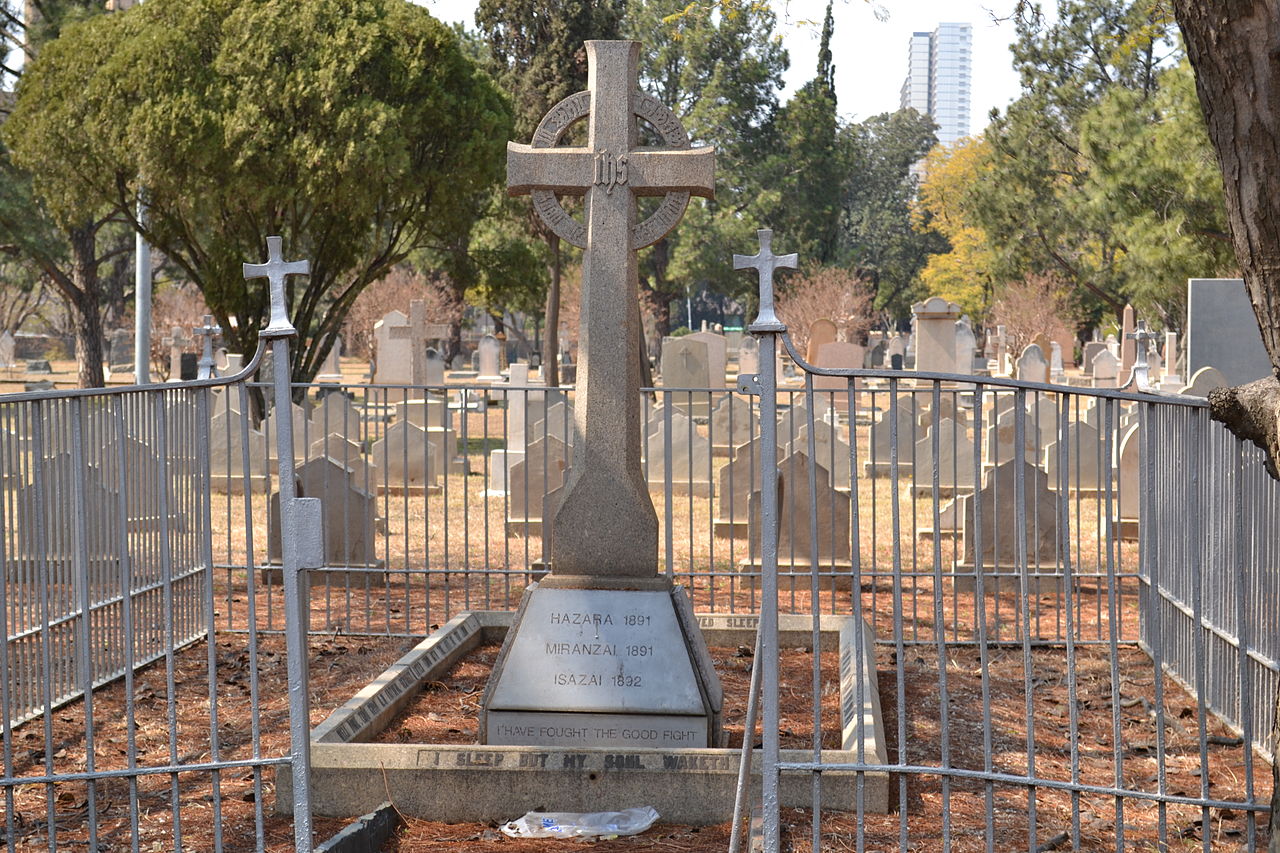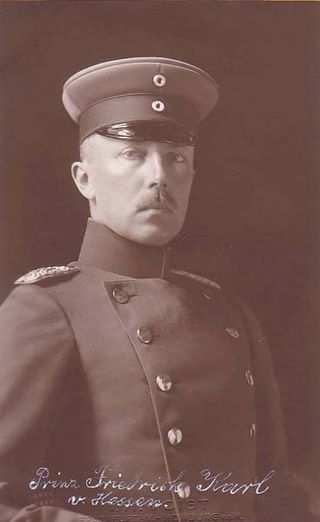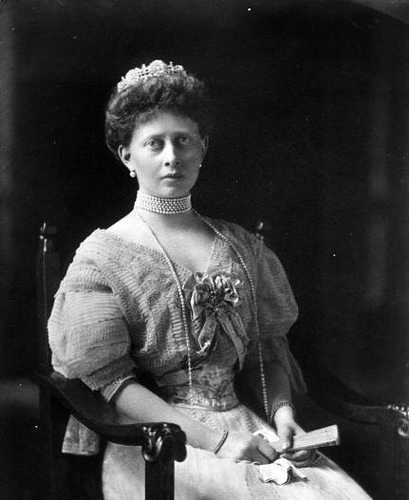by Susan Flantzer © Unofficial Royalty 2015

King Constantine I of the Hellenes; Credit – Wikipedia
King Constantine I of Greece was born on August 2, 1868, in Athens, Greece. Constantine’s birth was met with great joy in Greece as he would be the first Greek-born child of a modern Greek monarch. He was the eldest of the eight children of King George I of the Hellenes and his wife Grand Duchess Olga Konstantinovna of Russia, daughter of Grand Duke Konstantin Nikolaevich who was a son of Nicholas I, Emperor of All Russia. Constantine’s father was born Prince Vilhelm of Schleswig-Holstein-Sonderburg-Glücksburg and later became a Prince of Denmark when his father succeeded to the Danish throne as King Christian IX. When he was only 17 years old, Prince Vilhelm was elected King by the Greek National Assembly.
Constantine had four brothers and three sisters:

Greek Royal Family around 1890, Credit – Wikipedia
Although Danish-born King George I retained his Lutheran faith, all his children were baptized Greek Orthodox and learned Greek from birth. Constantine was tutored in Greek literature, mathematics, physics, and history by prominent university professors. In 1882, Constantine enrolled in the Hellenic Military Academy, the officer cadet school of the Hellenic Army. After graduation, Constantine received further military education in the German Imperial Army in Berlin. He also attended the University of Heidelberg and the University of Leipzig in Germany where he studied political science and business. In 1890, he returned to Greece and embarked on a military career. With the rank of Major General, Constantine took over the command of the 3rd Army in Athens.

Constantine in the field uniform of a Lieutenant General of the Greek Army in the 1890s; Credit – Wikipedia
During the summer of 1887, many European royals were in England to celebrate Queen Victoria’s Golden Jubilee. Queen Victoria was pleased to see a relationship developing between her granddaughter Princess Sophie of Prussia and Constantine. Constantine was not very bright, but as Queen Victoria wrote to her eldest child Victoria, Princess Royal, Sophie’s mother, “a good heart and a good character…go far beyond cleverness.” The couple became engaged shortly after the death of Sophie’s father Friedrich III, German Emperor in 1888. Despite having the approval of Queen Victoria and her eldest brother Wilhelm, now the German Emperor, Sophie did not have the wholehearted agreement of her mother. Her mother dreaded sending Sophie so far away, and she thought the stability of the Greek throne was uncertain and the country was considered underdeveloped. Nevertheless, Sophie and Constantine married on October 27, 1889, in Athens, Greece. They had a Greek Orthodox service at the Metropolitan Cathedral of the Annunciation and then a Lutheran service in the private Lutheran chapel of King George I of Greece.

Sophie and Constantine’s engagement photo 1889; Credit – Wikipedia
Sophie and Constantine had six children and there is a 23-year age gap between their eldest and youngest child.
- King George II of the Hellenes (1890 – 1947), married Princess Elisabeta of Romania, no children, divorced
- King Alexander of the Hellenes (1893 – 1920), married Aspasia Manos, had one daughter
- Princess Helen of Greece, Queen Mother of Romania (1896 – 1982), married King Carol II of Romania, had one son, divorced
- King Paul I of the Hellenes (1901 – 1964), married Princess Frederica of Hanover, had two daughters and one son
- Princess Irene of Greece, Duchess of Aosta (1904 – 1974), married Prince Aimone, Duke of Aosta, had one son
- Princess Katherine of Greece, The Lady Katherine Brandram (1913 – 2007), married Major Richard Brandram, had one son

Photo circa 1910, Top left: Constantine holding Irene, Top right: the future George II, Left: Sophia, Center: Helen, Right: the future Alexander I, Front: the future Paul I, Katherine is not yet born; Photo Credit – Wikipedia
On March 18, 1913, Constantine’s father King George I was assassinated and he acceded to the Greek throne as King Constantine I.

Swearing-in ceremony of King Constantine I before the Greek Parliament in 1913; Credit – Wikipedia
At first, Constantine was a popular king because of his success in the Balkan Wars of 1912-1913. Early in World War I, Constantine rejected a request from his brother-in-law Wilhelm II for Greece to join Germany and the Central Powers in the war. Many Greek people thought German-born Sophie, Constantine’s wife and Wilhelm II’s sister, supported Germany, but she was pro-British. Like her father, Sophie had been influenced by her mother, the British-born Victoria, Princess Royal. Greek Prime Minister Eleftherios Venizelos was strongly pro-Allies, having established an excellent rapport with the British and French, and was convinced that German aggression had caused the war. Constantine had decided upon a policy of neutrality because it seemed the best way to ensure that Greece would emerge from World War I intact and with the substantial territorial gains it had won in the recent Balkan Wars. The disagreement between King Constantine I and Prime Minister Venizelos was called “The National Schism” and would have repercussions in Greek politics until after World War II.

Constantine with Eleftherios Venizelos in 1913; Credit – Wikipedia
Despite the popularity of Venizelos and his clear majority in Parliament for supporting the Allies, Constantine continued to oppose the Prime Minister. In 1913, after the Balkan Wars, Greece signed the Greek–Serbian Alliance which obliged each country to come to the other’s aid should either be attacked. When Austria-Hungary invaded Serbia, Venizelos wanted to mobilize the Greek army and enter the war on the side of the Allies. Constantine, who was popularly considered to be a German sympathizer, refused. In an attempt to force the king’s hand, Venizelos allowed a British-French force to land in Thessaloniki, Greece in 1915 to aid the Serbs, establishing the Salonica Front. Constantine’s constant refusal to allow Greece to fulfill its treaty commitments led to the resignation of Venizelos as Prime Minister in September 1915.

King Constantine I of Greece in the uniform of a German Field Marshal, a rank awarded to him by German Emperor Wilhelm II in 1913; Credit – Wikipedia
Protests began to occur in Greece and threats on Constantine’s life were received. In July 1916, arsonists, possibly at the instigation of the Greek secret police, attempted to kill Constantine and some members of the Greek royal family while they were at Tatoi Palace, the summer palace outside Athens. The forest surrounding the palace was set on fire and due to the hot, dry weather, the fire quickly spread. Tatoi Palace was burned down, sixteen people were killed, and Constantine was injured but managed to escape with his family.
In August 1916, an Allied-supported popular revolt broke out in Thessaloniki. There, the former Prime Minister, Venizelos established a provisional revolutionary government, which declared war on the Central Powers. With Allied support, the revolutionary government of Venizelos gained control of half the country.
In the Royal Palace in Athens, Constantine was basically a prisoner. Only the veto of Russia’s Nicholas II, Emperor of All Russia prevented the British and French from deposing Constantine. That changed with the Russian Revolution in March 1917 when Nicholas II abdicated. In May 1917, supporters of Venizelos protested, calling upon the government in Athens to depose Constantine. The government in Athens realized that it was inevitable that this would happen. On June 10, 1917, Allied High Commissioner Charles Jonnart required King Constantine I to abdicate because he had violated his oath to rule as a constitutional monarch. The Allies were opposed to Constantine’s eldest son George becoming the king. George had served in the German army and was viewed as having German sympathies.
At a Crown Council in the Royal Palace, Constantine explained that he would leave because Athens would be a bloodbath if he did not. He named his second son Alexander his successor with the understanding that he would return to Greece after the war. The 23-year-old Alexander was horrified. Constantine told Alexander that he would be holding the throne in trust for him. Neither Constantine nor his son George would sign any renunciation of succession. On June 11, 1917, Constantine left Greece for exile in neutral Switzerland, and on June 30, 1917, Greece officially declared war on the Central Powers
In 1920, King Alexander died of blood poisoning as a result of sepsis from a monkey bite, and the third son Paul was asked to take over the throne. After Paul declined, Constantine was brought back after a change of government and a referendum allowing his return from exile. Constantine was enthusiastically welcomed by the Greek people but their enthusiasm did not last long. After a defeat in a war against Turkey in 1922, Constantine was forced to abdicate a second time and again go into exile. The crown went to his eldest son George, who reigned until 1925 when he was forced to abdicate. He was restored to the throne in 1936 and reigned until his death in 1947 when his younger brother Paul became king. Thus, all three sons of Constantine became Kings of Greece.
On January 11, 1923, Constantine died at the age of 54 from a brain hemorrhage in Palermo, Sicily. He was buried in the crypt of the Russian Church of Florence in Italy. With the restoration of the monarchy in 1936, the return of the remains of Greek royals to Greece was permitted. The Greek government sent the battleship Averof Brindisi to pick up the remains of Constantine, his mother Queen Olga, and his wife Queen Sophia, who had also died in exile. The battleship arrived in Piraeus, Greece on November 17, 1936. An official procession transported the remains to the Metropolitan Cathedral of the Annunciation in Athens where they lay in state for six days. He was then buried at the Royal Cemetery at Tatoi Palace near Athens, Greece.

Tomb of King Constantine I of Greece; Photo Credit – Wikipedia
This article is the intellectual property of Unofficial Royalty and is NOT TO BE COPIED, EDITED, OR POSTED IN ANY FORM ON ANOTHER WEBSITE under any circumstances. It is permissible to use a link that directs to Unofficial Royalty.
Greece Resources at Unofficial Royalty



























